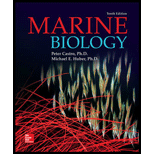
Two species of sea urchins live practically side by side on sandy bottoms. The two species appear to have the same diet: drift seaweeds and other bits of organic matter. They are able to live in the same environment with minimal competition. How might they be able to share their habitat and food
To determine: The way in which two species of sea urchins might be able to share their habitat and food resources.
Introduction: Coexistence of ecologically similar species may be defined as the act of cohabitation between similar species due to the difference in their use of potentially limiting resources such as food and water.
Explanation of Solution
Sea urchins are the marine creatures that inhabit the oceans all over the world. They can live in a variety of environments such as on rock pools, muds, coral reefs, and sea grass beds. Along with these, they can also lodge themselves half way into the surface of the sand, holes, or muds.
Coexistence of ecologically similar sea urchins might be possible when the competition between them reduces due to the reasons as follows:
- Being active at different times of the day.
- Feeding at different times of the day.
- Feeding at different levels in the sand. From the two species, one species may pick up the organic material slightly deeper in the sand than the other. This may cause slight differences in their feeding manner or food resource, which may help in the coexistence of sea urchins in the same habitat.
- Feeding at different areas. From the two species, one species may migrate to the rocky bottoms at night to graze on a different type of food.
- Differential ability to digest the organic material and/or the drift algae.
Want to see more full solutions like this?
Chapter 10 Solutions
Marine Biology (Botany, Zoology, Ecology and Evolution)
- please fill in the empty sports, thank you!arrow_forwardIn one paragraph show how atoms and they're structure are related to the structure of dna and proteins. Talk about what atoms are. what they're made of, why chemical bonding is important to DNA?arrow_forwardWhat are the structure and properties of atoms and chemical bonds (especially how they relate to DNA and proteins).arrow_forward
- The Sentinel Cell: Nature’s Answer to Cancer?arrow_forwardMolecular Biology Question You are working to characterize a novel protein in mice. Analysis shows that high levels of the primary transcript that codes for this protein are found in tissue from the brain, muscle, liver, and pancreas. However, an antibody that recognizes the C-terminal portion of the protein indicates that the protein is present in brain, muscle, and liver, but not in the pancreas. What is the most likely explanation for this result?arrow_forwardMolecular Biology Explain/discuss how “slow stop” and “quick/fast stop” mutants wereused to identify different protein involved in DNA replication in E. coli.arrow_forward
- Molecular Biology Question A gene that codes for a protein was removed from a eukaryotic cell and inserted into a prokaryotic cell. Although the gene was successfully transcribed and translated, it produced a different protein than it produced in the eukaryotic cell. What is the most likely explanation?arrow_forwardMolecular Biology LIST three characteristics of origins of replicationarrow_forwardMolecular Biology Question Please help. Thank you For E coli DNA polymerase III, give the structure and function of the b-clamp sub-complex. Describe how the structure of this sub-complex is important for it’s function.arrow_forward
 Biology: The Dynamic Science (MindTap Course List)BiologyISBN:9781305389892Author:Peter J. Russell, Paul E. Hertz, Beverly McMillanPublisher:Cengage Learning
Biology: The Dynamic Science (MindTap Course List)BiologyISBN:9781305389892Author:Peter J. Russell, Paul E. Hertz, Beverly McMillanPublisher:Cengage Learning Human Biology (MindTap Course List)BiologyISBN:9781305112100Author:Cecie Starr, Beverly McMillanPublisher:Cengage Learning
Human Biology (MindTap Course List)BiologyISBN:9781305112100Author:Cecie Starr, Beverly McMillanPublisher:Cengage Learning Biology: The Unity and Diversity of Life (MindTap...BiologyISBN:9781305073951Author:Cecie Starr, Ralph Taggart, Christine Evers, Lisa StarrPublisher:Cengage Learning
Biology: The Unity and Diversity of Life (MindTap...BiologyISBN:9781305073951Author:Cecie Starr, Ralph Taggart, Christine Evers, Lisa StarrPublisher:Cengage Learning
 Concepts of BiologyBiologyISBN:9781938168116Author:Samantha Fowler, Rebecca Roush, James WisePublisher:OpenStax College
Concepts of BiologyBiologyISBN:9781938168116Author:Samantha Fowler, Rebecca Roush, James WisePublisher:OpenStax College





